 |
|
|
CALLIOPE CALOYERA |
|
|
A Unique Artist and Trend-Setter
By Athan Karras |
|
| The motive as to why an artist is compelled to inscribe images on canvas or any surface available within reach is often intangible. We look at scenes and compositions of mixed colors called "art" and search for definitive words to describe the artist's intent. Trying to find words to describe such feelings is next to impossible, for it defies the essence of what motivates the artist to share their unique visual experience and individual interpretations. I spoke with Greek-born artist Calliope Caloyera Babu-Khan to learn what motivates her and she said, "My background with Greek, Indian, and other cultures has allowed me to develop my sense of color and line, and has influenced my inner expression. I have explored different techniques using oils, acrylics, drawings, print making, and collage. A series of themes and compositions of still life's and human figures are done using line and color that create positive and negative patterns of intense color and design." |
 |
| Several outstanding Greek painters have commanded attention in the contemporary art world. They have been prominently received in international art circles, with exhibits in main-stream galleries, their work covers the gamut of traditional, classical, representational as well as modern abstract idioms and they have matched their skills with the world's best artists of the past century. Most of these painters have been male, while Greek women artists have been given sparse recognition and so Calliope Caloyera Babu-Khan is unique as an artist and trend-setter. She began her preliminary art studies in Greece as a student at the Polytechnic Institute of Fine Arts in Athens. As a young art student, she spent a summer on the island of Mykonos where the Greek Government established an art center to encourage young artists by offering them residency in places like Delphi, Hydra, and Mykonos. Calliope is hesitant and at moments inarticulate about explaining her art. She feels that it is not up to the artist to talk about her art; once a painting is created, it speaks for itself. She was always interested in art; it was an obsession of hers ever since she was five years old. In her youth, the Caloyeras family vacationed on the island of Syros and one day while at a cafe with parents and friends, she impulsively started to draw on the tablecloth. A guest quickly exclaimed that Calliope was destined to be an artist. They stayed by the beach in Syros and each morning she wandered on the private sea-shore collecting colored sandstones, which she smashed and turned into pigments for her paintings; the beach became her own paint store. Her father was from the island of Spetses, while her mother's family moved from Patras to Athens. She feels extremely fortunate that her parents were art lovers. |
|
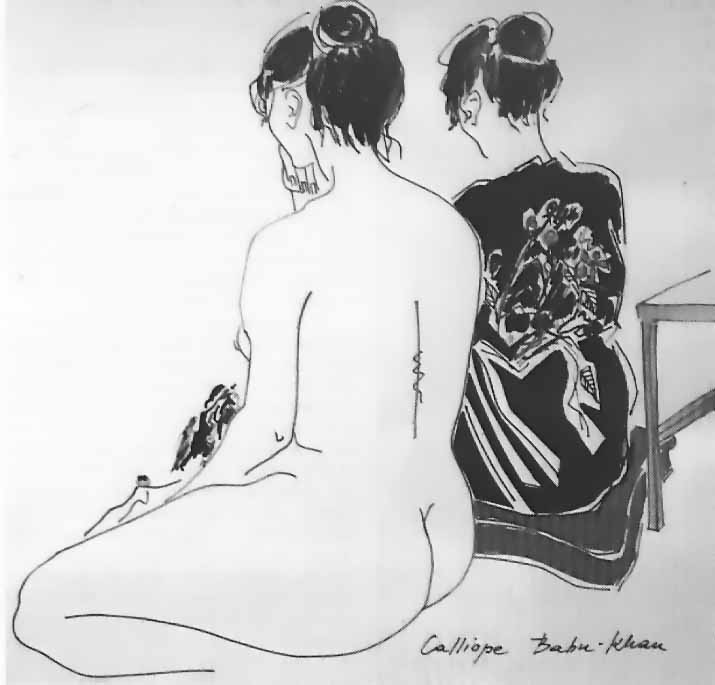 |
Her mother noticed very early on that Calliope had an ardent desire for art, so she enrolled her in a nearby art studio. The preparatory studio helped the young artist apply for entrance examinations at the Polytechnic Art Institute and Calliope recalled, "We would sketch first in line drawings, afterwards we did them in charcoal, and eventually from the busts we would have to complete figures. All this was before I finished high school." For her week-long entrance exams she had to draw a portrait of alive model in charcoal, draw figures from statues, and complete an original composition. The applicants were then judged on these three tasks. Getting into the Art Department at the Polytechnic was not easy; openings were limited but once accepted, she was fortunate to study under such masters as Yannis Morallis. After graduating from the Polytechnic, her parents openly encouraged Calliope to continue her studies in art even if it meant going abroad. She considered continuing her studies in Paris, which seemed exotic and romantic. Instead, her parents recommended she consider going to America where she would be closer to her brother who was attending North Carolina University. |
| She was offered a scholarship at the California School of Fine Arts in San Francisco, currently called the San Francisco Art Institute. Upon completing her studies, Calliope thought she'd go to the Big Apple; New York was a famous art center, but a couple very good friends in Los Angeles diverted her. Dina Oldnow of the Skouras family, well known in the movie industry, was instrumental in arranging an interview with the Art Department at UCLA, where she was accepted for graduate work. Compared to Northern California, she enjoyed the lifestyle and environment of Los Angeles finding the climate similar to Greece, so dreams of New York fell by the wayside. Her brother Peter visited her after graduating from North Carolina University., interviewed for jobs, and quickly landed a position in electrical engineering. Calliope found work in design; both applied for extensions on their visas and waited for permanent residency in America, which took about five years. Though Calliope wanted to explore graduate studies, she realized that an education in art is not restricted to learning new techniques and methods. What artists mostly need is a way to tap into their psyche and expand their imagination while remaining true to their identity. |
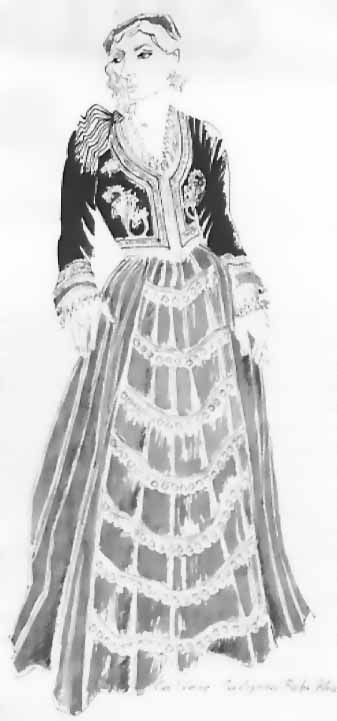 |
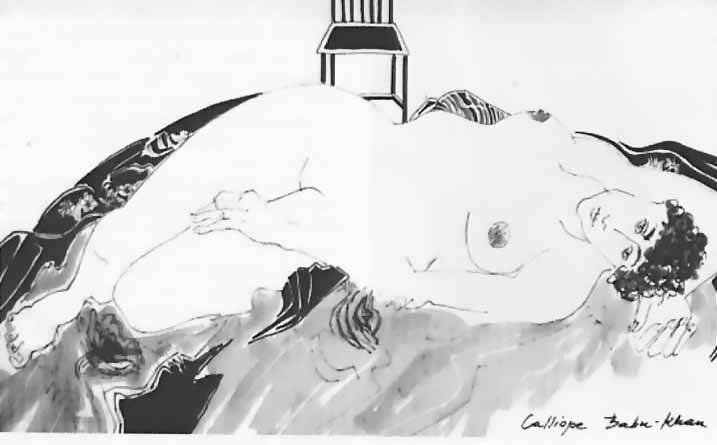 |
The art of painting is a personal vision, expressing a multitude of the artist's experiences and focusing on that vision by integrating form with color. This constant challenge of reliving or recreating visual images be they realistic or impressionistic eventually constitutes the artist's creation and personal expression defined as "art." Calliope began exhibiting with small groups as she explored the unique role of women painters. She married a fellow UCLA student from India, Sefi Babu-Khan, and with his full support and encouragement, she explored different techniques combining her new exposure to the intriguing and fascinating world of colorful India with the visions of Greece seen first in her early childhood. This cultural fusion emerged as major influence on her work. Marriage helped her focus on being an artist as she never had to think for a moment about making a living. What mattered most was to continue drawing and painting; that is what she felt she had to do. |
| "I don't know how but it just never crossed my mind about making money from art. I can imagine that those artists whose art is selling today in the millions would have ever imagined that it would turn out that way. When we think about it really, how peculiar it is that being an artist we just don't place us ourselves on the same economic strata, yet we also have expenses, we need to eat and live, yet we have separated ourselves from the rest of the world, people who are entangled in those daily routine jobs. Strangely enough I like to give my works to people. I had an exhibit at LMU with paintings on Greek themes. One of the paintings exhibited depicted a scene of the Kastella area outside of Athens. A friend on seeing it quickly remarked that this is the place where she grew up. Well, after the exhibit I told her, 'I'll give it to you.' So, she returned a few days later and I gave it to her even though she offered to buy it, I couldn't accept money from a friend. When you come down to it, it appears that it is a case of placing value, not only on the painting, but placing value as to who will truly appreciate it and deciding as to what is more important at the time. But I have also discovered that unless people pay something for art, they don't always value it." Some of Calliope's most distinctive works are award-winning "biography" paintings that pay homage to individuals who have inspired her. They are exuberant tributes composed of a multitude of images conveying his or her accomplishments. Among her numerous exhibits in the US and abroad, she is especially proud of being part of a formidable exhibit of 150 works representing 83 artists from twelve countries at the Los Angeles Museum of Art simply titled "Women Artists." One of her distinctive multi-layered drawing-paintings won first prize in the juried exhibit called "Women Painters in 1991." In honor of the US Bi-Centennial Anniversary, she mounted an exhibit at Loyola Marymount University paying homage through the depiction of ancient Greek gods from the Olympian pantheon: from Athena, Apollo and Aphrodite to Poseidon. She imposed upon Professor Hugh Gray, a Greek scholar who helped her brother Peter establish the Basil P. Caloyeras Center for Modern Greek Studies at LMU, to obtain university support for her project. Calliope and Peter helped fund the LMU Center for Modern Greek Studies in the name of their beloved father who believed it was important that his children commemorate the culture of their native Greece in America. During the 1984 Olympics in Los Angeles, Babu-Khan commemorated the relationship between Athens and Los Angeles with an enormous 6'x 8' line drawing in black enamel paint depicting the two cities represented by two classic profiles. Los Angeles is shown with freeways as headgear, wings of angels, a palm tree, and the City Hall with the Olympic flame blazing at its top. |
|
| Athens is represented by an owl on her headdress, a symbol of wisdom and her connection with goddess Athena. The two figures are looking at each other because they are related; the flame came from Olympia to Los Angeles and returned to Athens. It is Calliope's concept of continuity through the centuries. This symbol has since been adapted the Athens / Los Angeles sister city affiliation as their official logo. During the 2004 Olympics in Athens, Babu-Khan hosted several artistic events called "paint outs" to celebrate and commemorate the sister city bond between Los Angeles and Athens. I was fortunate to work with the very inventive Calliope at the Los Angeles Folk Art Museum's Festival of Masks. I had been invited to present the satyr play of Euripides, The Cyclops. We were considering how to construct a mask depicting the giant Cyclops and within minutes, Calliope suggested that we create a huge mask and place it center stage. Within minutes she concocted the ten-foot mask out of my garden by pulling together huge palm branches and drying husks with various loose leaves to form the one-eyed giant as if it had risen from the earth. The actor's booming voice was amplified to measure up to the stature of this magnificent mask and we presented the play successfully thanks to the imagination of the artist. |
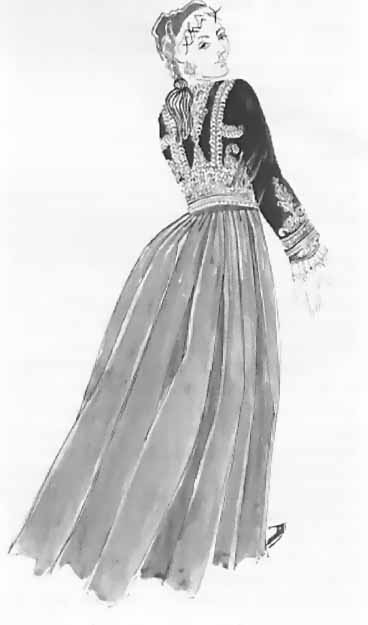 |
| In addition to her devotion to Greek culture, Calliope has learned to love and appreciate her husband's homeland India where she has been vastly influenced by its mythological legacy and outlandishly displayed brilliant colors. She has exhibited in Greece and India, and most importantly, she has tried to bridge these worlds in her work. She does not consider her work to be purely Greek. What concerns her most is to remain motivated by allowing the influences of various fascinating civilizations to be reflected in her work; the temples of India, the multicolored saris, which are now interwoven in her paintings and murals depicting Indian and Greek gods and goddesses. She thinks that perhaps she ought to do something unusual, something different, and feels embarrassed at times for not achieving it yet. Artists often reach an impasse and introspectively search for what to do next. When we met recently to discuss her art work, Calliope told me, "In my statement, I mention how I have been influenced, most particularly by India. Being married to wonderful man from India and having visited India I developed a great kinship and appreciation for Indian art, but most emphatically I was greatly influenced by their use of color. India and Greece share a common cultural affinity; ever since Alexander the Great who had reached as far as India. The colors in India are amazing. "I was struck for instance, in Rothko, in his paintings; he blends colors together in his works. We went to major garment exhibit of cotton industries with my husband in India, and Sefi was interested in buying saris for the servants, not the expensive silk saris, these were cotton that you could have imagined were just out of Rothko's paintings. I felt sure he must have seen these in India or something similar. I picked up several not necessarily to wear but for the color schemes. I am also fond of Japanese art which is equally very powerful." |
|
| "I like drawing and painting people and especially the human figure, face, hands, feet-the works. 1 enjoy drawing people and I do it constantly. First step in drawing a person, you go over the outline, but must not remain within the realistic representation; an artist is required to make an interpretation of that visual experience. I look for those special characteristics, whatever will help individualize that person. I like to have them pose in different poses, and this then helps me construct a composition. For example it's fun to draw a figure posing in different activities, such as in movement, establish as many variations as I can have on one page with different poses of figures. Many times people we draw have expectations of themselves; they view themselves in a certain way, so when they see the artist's result, they don't look like what they think they should look like, that is why I don't like to draw people I know very well. I don't have to explain anything or have misunderstandings." |
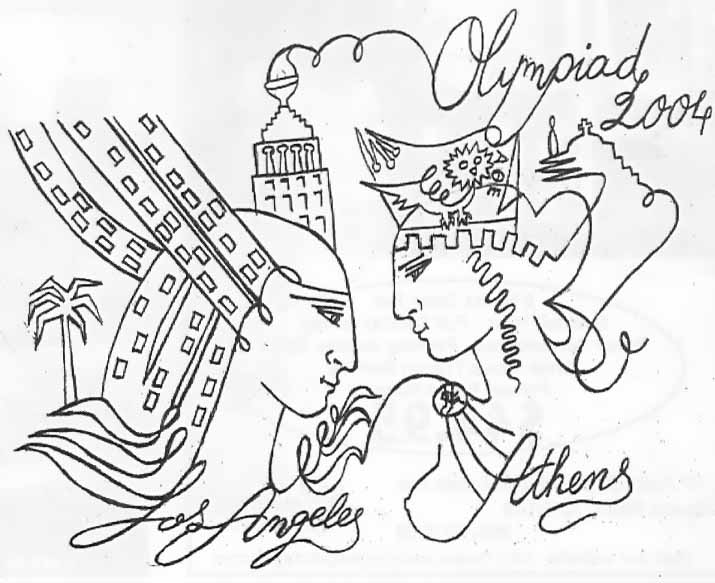 |
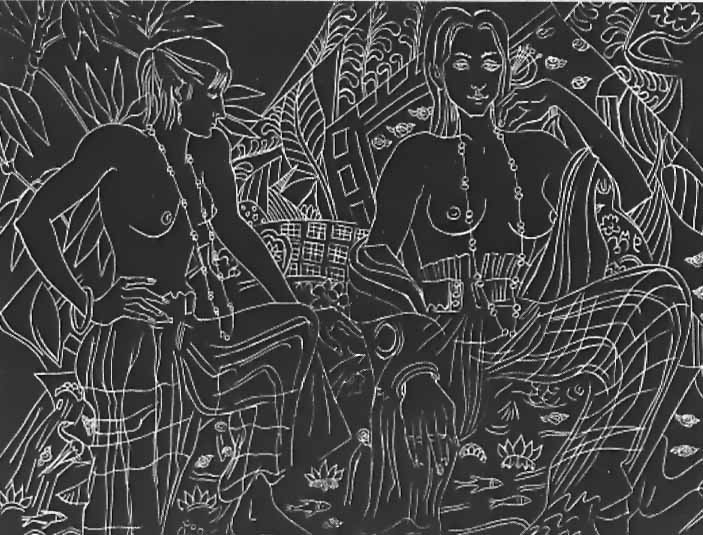 |
"My life in art has been enervating, I am always involved with the way I live with my family and the world that is presented to me each day. These revelations and perceptions that spontaneously reflect the interpretation I will express on a canvas, with my feelings leading the way to be viewed in a painting. I become totally engrossed in what I am doing, that for that moment, it is my whole world and I don't need anything else outside of what I am doing. That kind of concentration and involvement is my fascination and I thoroughly enjoy it. Though I am given to spontaneous expression, having studied and given certain firm principles, the discipline one earns through study and education, as sure the artist of having certain control and continuity in their work. |
Though I never really know what the end result will be and in a way that's part of the magic of personal discovery, we don't really want to know, the process and the discovery is the magic of creation. In the process of working on an art piece, I attempt at trying several directions, no firm decisions are made, and I continue searching, asking myself, as to how it affects me and the final decision often may well be different than that originally imagined. This is not only as to the subject, as dimension and proportion are also to be considered, and that too will often change. The only way we can decide on that, is when we know before hand that it is being directed to a particular space, with an established dimension." "I recall once on seeing a painting in America. It was an abstract painting where two items were the subject, a telephone and a palm tree. I struggled trying to figure out what was this painter was trying to say and why was it so important. I speculated that perhaps the palm tree represented Los Angeles and the telephone represented modern communication. Somehow this artist was caught in between these objects, that of nature and that of man made technology. So, it is amazing to see how different cultures express themselves. We are all so different, yet equally fascinating." "I try to speculate if my strongest influences are from my Greek back-ground, or from the years I lived in America, or perhaps from my travels especially in India. But truly I think that more you have seen the better it is, in having the knowledge of what is happening in the world around you. They are very different. Japan is different from India; India is different from Greece. Of course there are perhaps certain similarities from the past. Every culture has a distinct style, so I think if you like color then you can respond to Indian culture because you love the idea of color so very much. We can't say whether you have been influenced by that culture, or that you may have it inherently, which validates what you feel." In addition to cultural influences, nature can affect how one paints. Calliope said, "Take for instance, the difference if I was painting in Greece or painting in America, there are the environmental influences such as the light. In Greece-it's so much more vivid and penetrating and brilliant. I don't know if there could be another place as brilliant as Greece. It hits you; it's a different feeling in Greece. Also I have felt, being away from Greece, that I look through a window and I see the light not being there and the painter Fassianos told me the same thing about when he was in Paris. |
|
| Beyond all her achievements and many paintings that are dispersed throughout the world, she returns to the island of Spetses almost every summer, inviting friends and family to join her at the family home she has be reconstructing. It is also here that she connected spiritually with that famous heroine Laskarina Bouboulina, the first and perhaps only woman naval admiral in Greece who fought valiantly against the Ottoman Empire in the War of 1821. | |
 |
Bouboulina hailed from Spetses and her legacy is being restored at her home where Calliope is single handedly creating a museum for the islanders and all of Greece to remind everyone of Bouboulina's legacy commemorated in Calliope's "biography" paintings to forever mark this important figure in the modern history of Greece and for women's issues worldwide. "I love Athens, but in Spetses I love the past where we have our ancestral house. When I go to Spetses, I get of the boat and immediately I notice the waters are so blue and so bright." We have a house in Athens in Filothei where I grew up, but I care less about it. Nothing else matters. But this house I find it very, you know, I go there, my ancestors have lived there, and I feel very good in that house and secure, being around the same walls as my ancestors." |
|
HCS readers may wish to view other articles and releases in our permanent, extensive archives at the URL http://www.helleniccomserve.com/contents.html. |
|
 |
|
|
2000 © Hellenic Communication Service, L.L.C. All Rights Reserved. http://www.HellenicComServe.com |
|